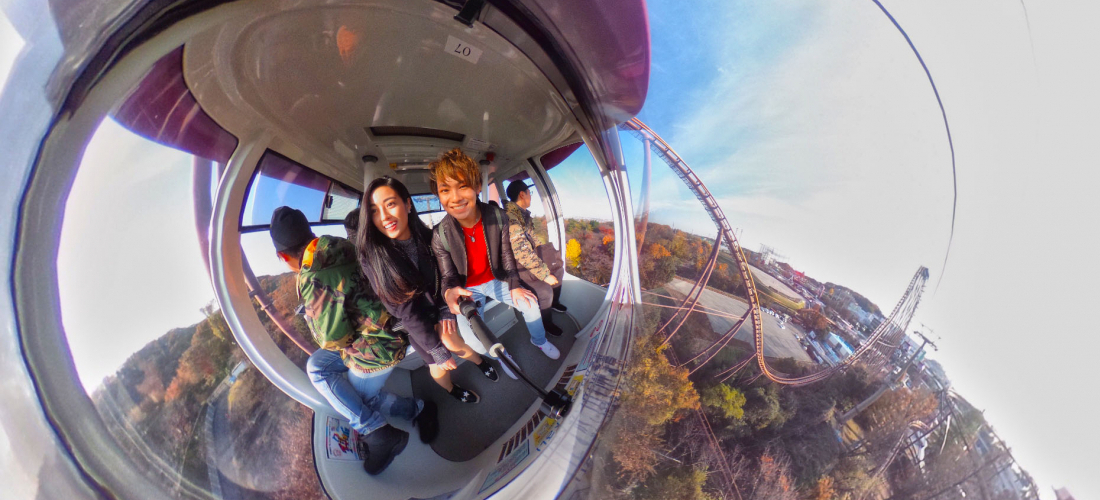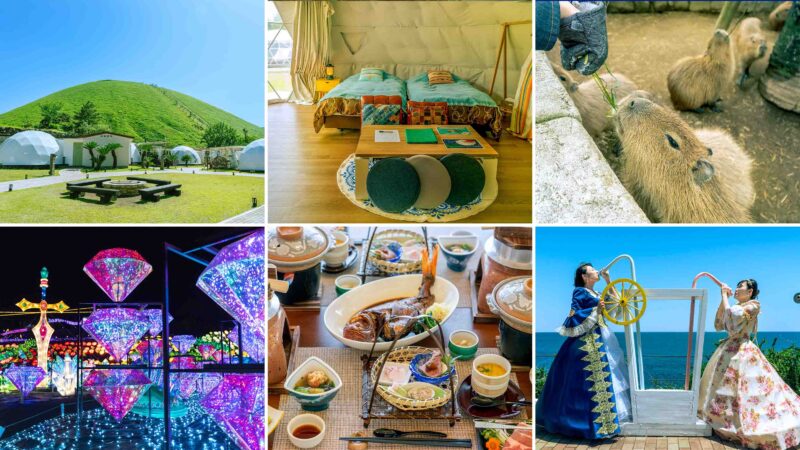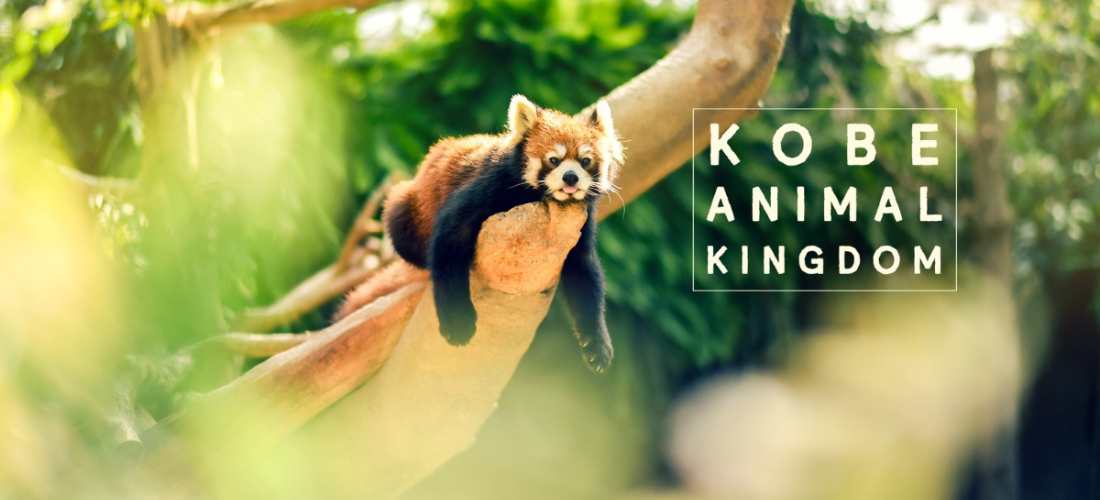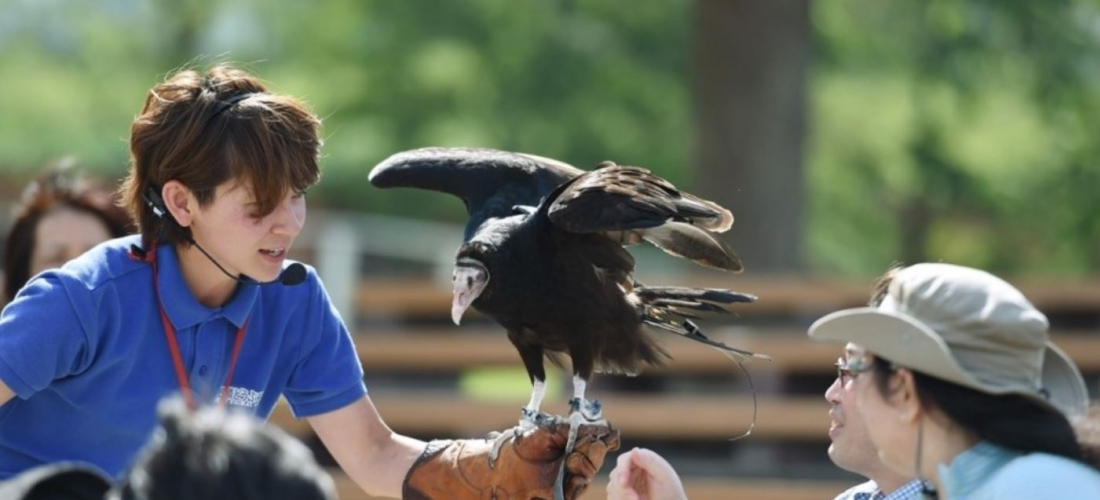CONTENTS
Enjoy one-on-one time with Japan’s capybaras at these three Japanese zoos and aquariums!
Capybaras in Japan
In Japan, capybaras are icons of relaxation, and in this busy, bustling country there’s nothing more in demand than the peaceful feeling you get when interacting with cute animals like the capybara. With their bristly brown fur, their round shape, and their funny little legs, the capybara might seem like a funny choice to become a Japanese favorite, but the popularity of the world’s largest rodent is on the rise in Japan. Capybaras are native to the swampy rivers and lakes of South America, and they first arrived on Japan’s shores in the 1960s, when they were brought over for some slightly less cute and fuzzy research. (Let’s all say it together: capybaras are friends, not food.) But after making a big splash in Japan’s zoos and aquariums (literally, capybaras are semi-aquatic), the people of Japan have grown to appreciate the capybara’s tranquil, unruffled, and content attitude.
These days capybaras appear on TV, in ads, and as cute character merchandise, and they’ve become a major attraction at more than 100 zoos and aquariums around Japan, where visitors flock to their enclosures to borrow a little of their gentle contentment and feel their heart-warming magic. Since capybaras are so incredibly mellow and friendly with just about any other animal (and so incredibly cute too), there are a number of spots around Japan where you can do more than just look at them behind glass. Check out a few of our favorite places to feed capybaras tasty leaves, stroke their course fur, and even enjoy the sight of capybaras relaxing in a lovely traditional Japanese-style bath.
① Izu Shaboten Zoo
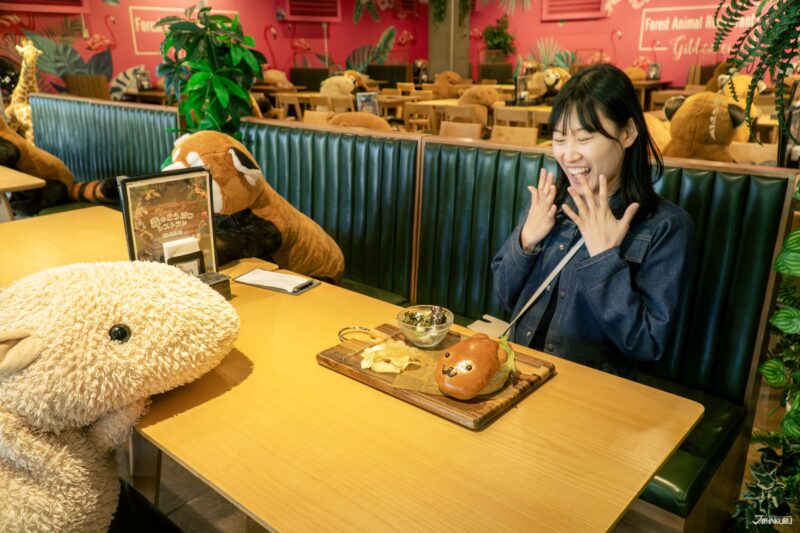
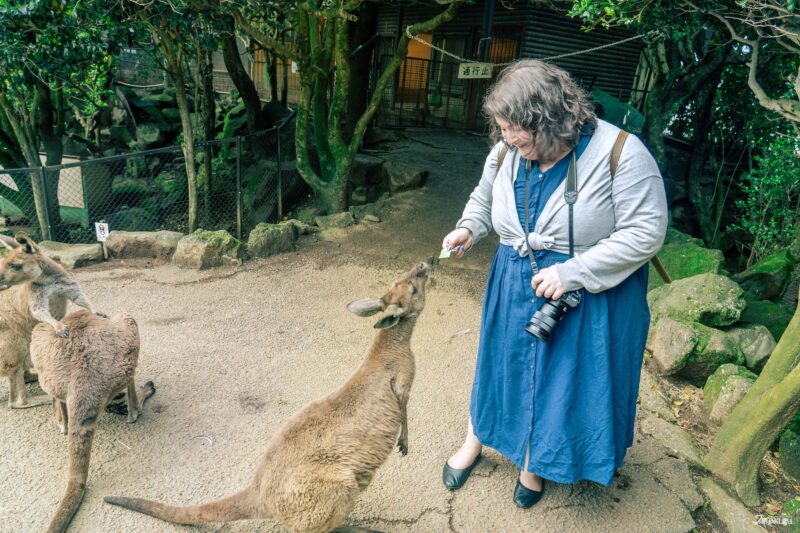
Located on the scenic Izu peninsula, tucked in between the mountains, the sea, and plenty of hot springs, Izu Shaboten Zoo is a unique example of a “zoological garden,” with somewhere around 140 species of animals and 1,500 species of cacti and other succulents. In the 1960s, Izu Shaboten Zoo was one of the first facilities in Japan to receive capybaras from South America, and while they have plenty of popular residents (the red pandas and kangaroos are quite charming), over the years the capybaras have become the de facto mascots. The capybaras don’t quite have free reign of the zoo like the peacocks and squirrel monkeys do, but visitors can purchase leafy snacks for the capybaras by their enclosure. It’s not hard to while the day away feeding them treats and patting their bristly heads! And when your stomach starts to growl and you get jealous of the happily munching capybaras, you can head to the zoo’s Gibbontei Forest Animal Restaurant for an adorable capybara-shaped burger.
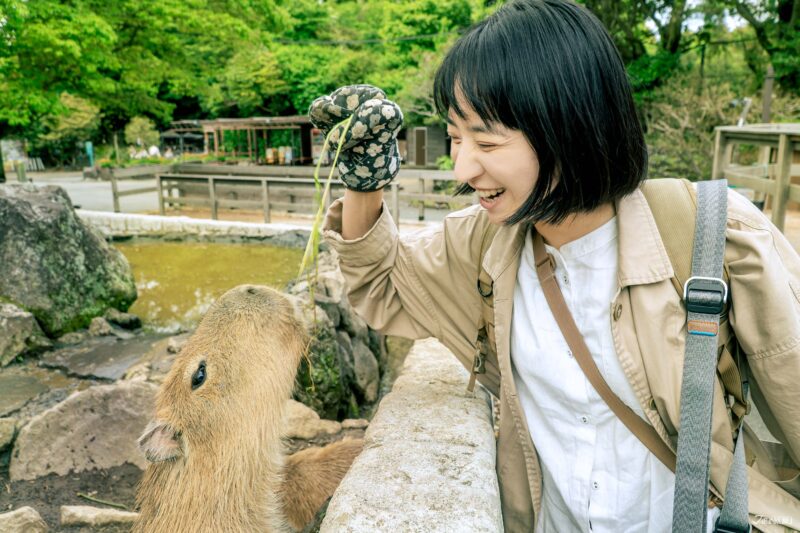
Izu Shaboten Zoo’s capybara habitat is also famous for its large outdoor bathtub, which is filled with warm water for the capybaras to soak in during the cooler months of the year. Just like many Japanese public baths for humans, a variety of fragrant additions are added to the steaming bath throughout the year, including yuzu fruit, rose petals, and hinoki cypress wood, although it’s unclear if this is really for the capybara’s enjoyment or for ours. There’s no denying how cute their twitching noses look sitting just above the water line in a bath filled with bobbing yellow yuzu! Spend the day watching the capybaras enjoy their bath, then head back to your own Izu hotel for a soak in their hot springs!
Izu Shaboten Zoo (伊豆シャボテン動物公園)
1317-13 Futo, Ito, Shizuoka
Hours: 9:30 – 17:00 (hours may vary season to season)
Admission:
weekdays: adults 2,700 yen | elementary school students 1,300 yen | children 4+ 700 yen
weekdays: adults 2,800 yen | elementary school students 1,400 yen | children 4+ 700 yen
Official Website (jp)
② Kawasui Kawasaki Aquarium
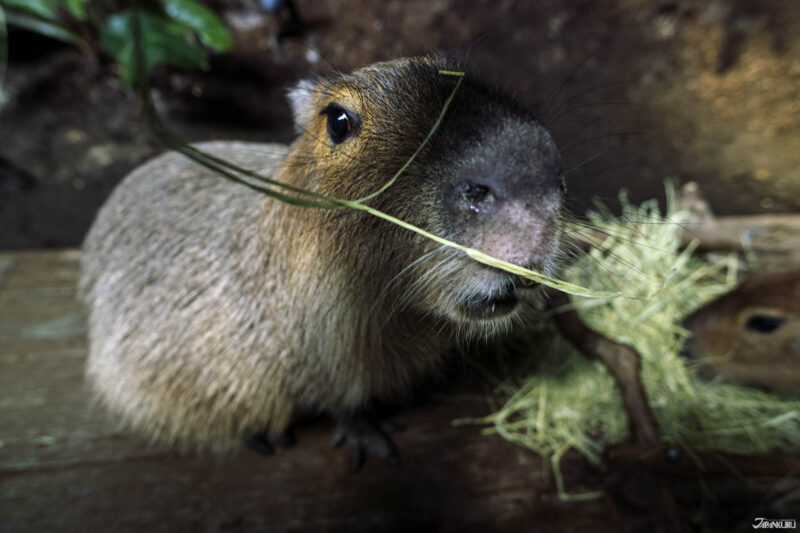
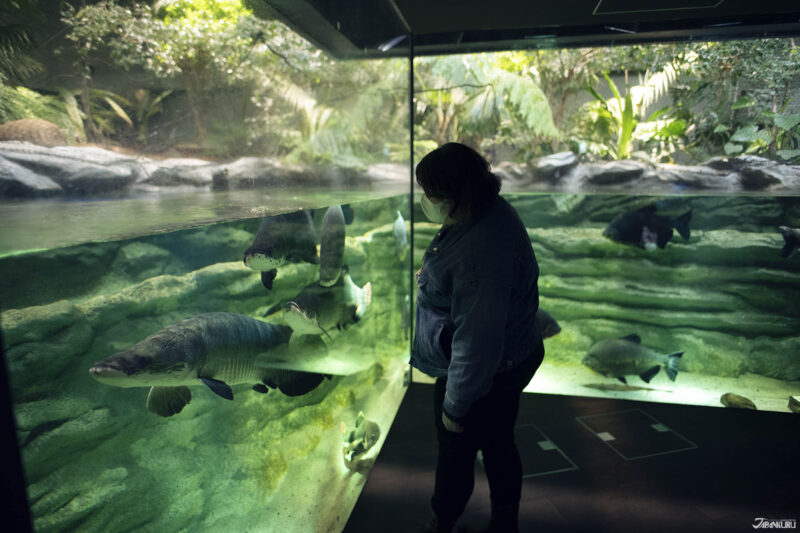
The city of Kawasaki sits pressed up against Tokyo’s southern border, and the aquarium is right across the street from the train station, which means Kawasui is probably the easiest place to pet capybaras in the Tokyo area! Take a break from the Japanese capital to visit this spot and you’ll be treated to a beautiful modern aquarium with tanks full of both local Japanese aquatic life and captivating animals from far-flung locales, and, of course, some very sweet capybaras.
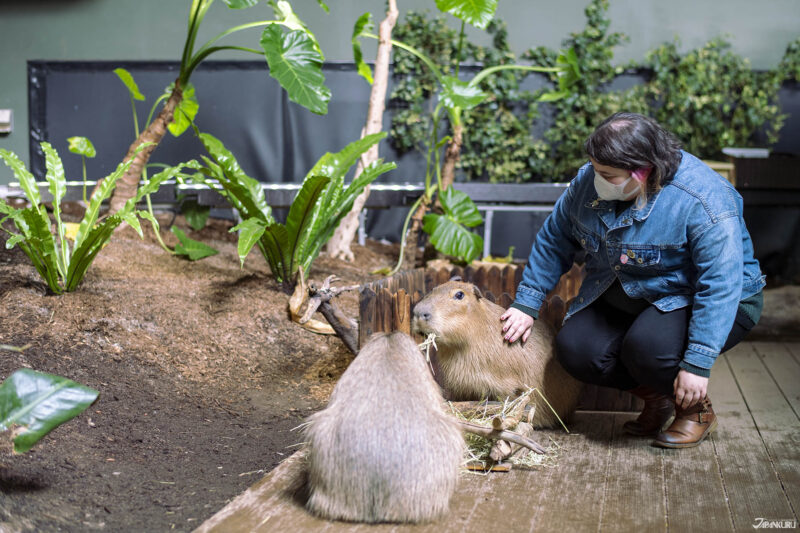
The compact size of this aquarium next to the train station means that they can only keep a small number of capybaras in comfort, but that means the friendly animals are all the more intrigued by new visitors – like you. Check the hours of the Agua Terra habitat where the capybaras live, then get in there and pat some smooth round capybara backs! If you want them to really love you, you can buy them a treat for an additional 300 yen.
⇨ More on Kawasui Kawasaki Aquarium
Kawasui Kawasaki Aquarium (カワスイ 川崎水族館)
10F Kawasaki Le Front, 1-11 Nisshincho, Kawasaki Ward, Kawasaki, Kanagawa
Hours: 10:00 – 20:00 (last admission 19:00)
Admission: adults 2,200 yen | high schoolers 1,700 yen | elementary & middle schoolers 1,400 yen | children 4+ 800 yen
Official Website (jp)
③ Nasu Animal Kingdom
Nasu is a picturesque mountain resort area in Tochigi Prefecture, a few hours north of Tokyo, and although it’s largely popular as a getaway spot with luxurious hotels and natural hot springs, it’s also home to the zoological paradise called Nasu Animal Kingdom. Not far from the Japanese emperor’s vacation home, this zoo has an outdoor area with an assortment of farm pastures full of grazing sheep and deer, impressive shows with birds swooping through the air, and an indoor area with red pandas, jaguars, and the “capybara forest.”
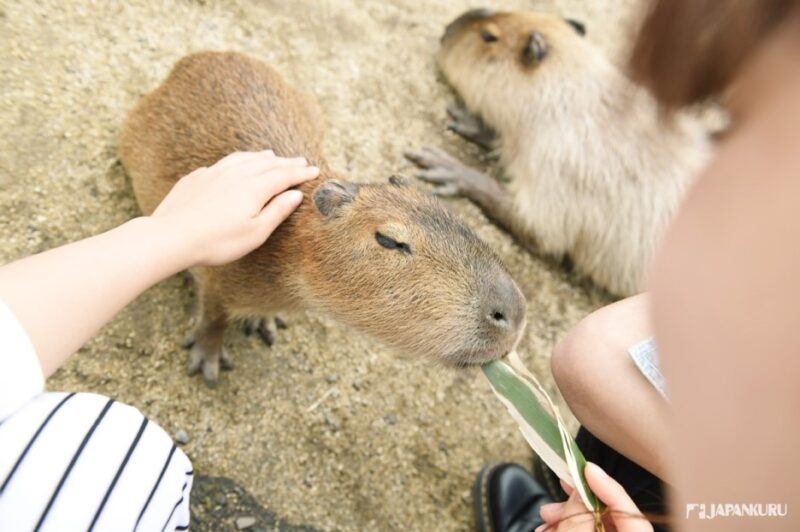
Pay an extra hundred yen for some capybara treats and you can enter the forest to join the capybaras, handing out tasty leaves like Santa with a big sack of presents, and making lots of spikey friends along the way. Since Nasu is also a hot spring area, Nasu Animal Kingdom has its own luxurious bath for the capybaras, often surrounded by snow in the winter. On the coldest days of the year, it’s hard not to envy the capybaras as they luxuriate in the hot water.
Nasu Animal Kingdom (那須どうぶつ王国)
1042-1 Oshima, Nasu, Nasu District, Tochigi
Hours: weekdays 10:00 – 16:30 | weekends/holidays 9:00 – 17:00 | winter hours (late Dec to late Feb) 10:00 – 16:00 | closed Wednesdays
Admission: adults 2,600 yen | children 1,200 yen | adults (winter) 2,000 yen | children (winter) 1,000 yen
Official Website (jp)
④ Kobe Animal Kingdom

It’s easy to focus on zoos and aquariums close to Tokyo, but Kobe Animal Kingdom is (shockingly) in Kobe – a major city in western Japan, and not far from Osaka or Kyoto. It’s also one of the most interactive zoos you’re ever likely to visit, with opportunities to pet or feed over a dozen different animals, and get up close to even more. The penguin, alpaca, and seal areas are all pretty tempting, but of course, we’re here for the capybaras.
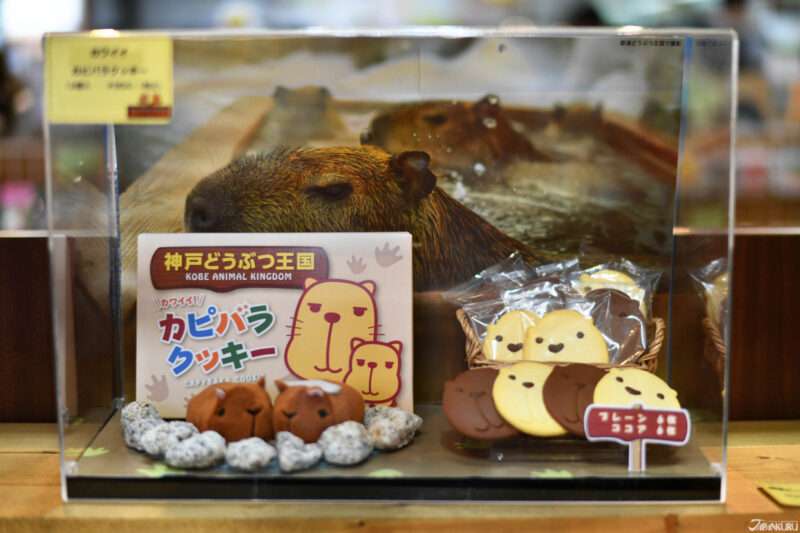
Enter the zoo’s marshy grassland habitat, named after South America’s Pantanal region, and you’ll find a small herd of capybaras lounging in the pools, sleeping in the sand, and searching out visitors with leaves in hand. Capybara food costs 100 yen at Kobe Animal Kingdom, but it’s always worth it to give the capybaras a reason to come close and hang out! It’s cheaper than the tantalizing capybara cookies they sell in the gift shop, at least.
Kobe Animal Kingdom (神戸どうぶつ王国)
7-1-9 Minatojima Minamimachi, Chuo-ku, Kobe-shi, Hyogo
Hours: 10:00 – 17:00 (hours vary, please check before departing)
Admission: adults 2,200 yen | elementary school students 1,200 yen | children 4-5 y.o. 500 yen | seniors 65+ 1,600 yen
Official Website (en)
Make New Furry Friends on Your Next Trip to Japan
Whether you’re planning to stick to the Tokyo area, head off into the mountains, relax by the sea, or explore the western cities, Japan is so in love with capybaras that there are amazing capybara destinations all over the country. Relax among the best of them, and bring a little peace and contentment to your soul, by heading to one of our favorite spots and meeting some capybaras on your next trip to Japan!
Half a lifetime ago I came to Japan for a semester abroad... and I never left. I guess I really like the place! I spent my first few years in Japan living in the middle of nowhere, so I'd love to hear your Tokyo recommendations via Japan's social media accounts!
COMMENT
FEATURED MEDIA
VIEW MOREMAP OF JAPAN
SEARCH BY REGION

LATEST
VIEW MOREEVENT CALENDAR
VIEW MOREMOST POPULAR
 Tokyo Winter Recommendation: Don’t Miss Tokyo Mega Illumination, Japan’s #1 Light Show
Tokyo Winter Recommendation: Don’t Miss Tokyo Mega Illumination, Japan’s #1 Light Show ป้ายยาสินค้าน่าซื้อในร้านขายยาญี่ปุ่น | KOWA ผลิตภัณฑ์เพื่อสุขภาพสำหรับคนยุคใหม่
ป้ายยาสินค้าน่าซื้อในร้านขายยาญี่ปุ่น | KOWA ผลิตภัณฑ์เพื่อสุขภาพสำหรับคนยุคใหม่ Okinawa Family Road Trip: Japanese Glasses Shopping at San-A Urasoe West Coast PARCO CITY, Discount Coupons, & Okinawa Sightseeing with JINS
Okinawa Family Road Trip: Japanese Glasses Shopping at San-A Urasoe West Coast PARCO CITY, Discount Coupons, & Okinawa Sightseeing with JINS


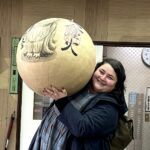



 >> Find out more at Japankuru.com! (link in bio)
#
>> Find out more at Japankuru.com! (link in bio)
#





 The Robot Restaurant is gone, but the Samurai Restaurant is here to take its place. Check it out, and don't forget your coupon!
The Robot Restaurant is gone, but the Samurai Restaurant is here to take its place. Check it out, and don't forget your coupon!
 신주쿠의 명소 로봇 레스토랑이 사무라이 레스토랑으로 부활! 절찬 쿠폰 발급중
신주쿠의 명소 로봇 레스토랑이 사무라이 레스토랑으로 부활! 절찬 쿠폰 발급중
 18歲以上才能入場的歌舞秀,和你想的不一樣!拿好優惠券去看看~
#tokyo #shinjuku #samurairestaurant #robotrestaurant #tokyotrip #도쿄여행 #신주쿠 #사무라이레스토랑 #이색체험 #할인이벤트 #歌舞伎町 #東京景點 #武士餐廳 #日本表演 #日本文化體驗 #japankuru #japantrip #japantravel #japanlovers #japan_of_insta
18歲以上才能入場的歌舞秀,和你想的不一樣!拿好優惠券去看看~
#tokyo #shinjuku #samurairestaurant #robotrestaurant #tokyotrip #도쿄여행 #신주쿠 #사무라이레스토랑 #이색체험 #할인이벤트 #歌舞伎町 #東京景點 #武士餐廳 #日本表演 #日本文化體驗 #japankuru #japantrip #japantravel #japanlovers #japan_of_insta
 코지마 x 빅 카메라 쿠폰으로 일본 가전 제품 쇼핑하기
#pr #japankuru #japanshopping #kojima #biccamera #japaneseskincare #yaman #dji #osmopocket3 #skincaredevice #日本購物 #美容儀 #相機 #雅萌 #日本家電 #일본여행 #면세 #여행꿀팁 #일본쇼핑리스트 #쿠폰 #일본쇼핑 #일본브랜드 #할인 #코지마 #빅카메라 #japankurucoupon
코지마 x 빅 카메라 쿠폰으로 일본 가전 제품 쇼핑하기
#pr #japankuru #japanshopping #kojima #biccamera #japaneseskincare #yaman #dji #osmopocket3 #skincaredevice #日本購物 #美容儀 #相機 #雅萌 #日本家電 #일본여행 #면세 #여행꿀팁 #일본쇼핑리스트 #쿠폰 #일본쇼핑 #일본브랜드 #할인 #코지마 #빅카메라 #japankurucoupon
































 Oita Hello Kitty Airport
Oita Hello Kitty Airport  Lands April 13th
Lands April 13th









